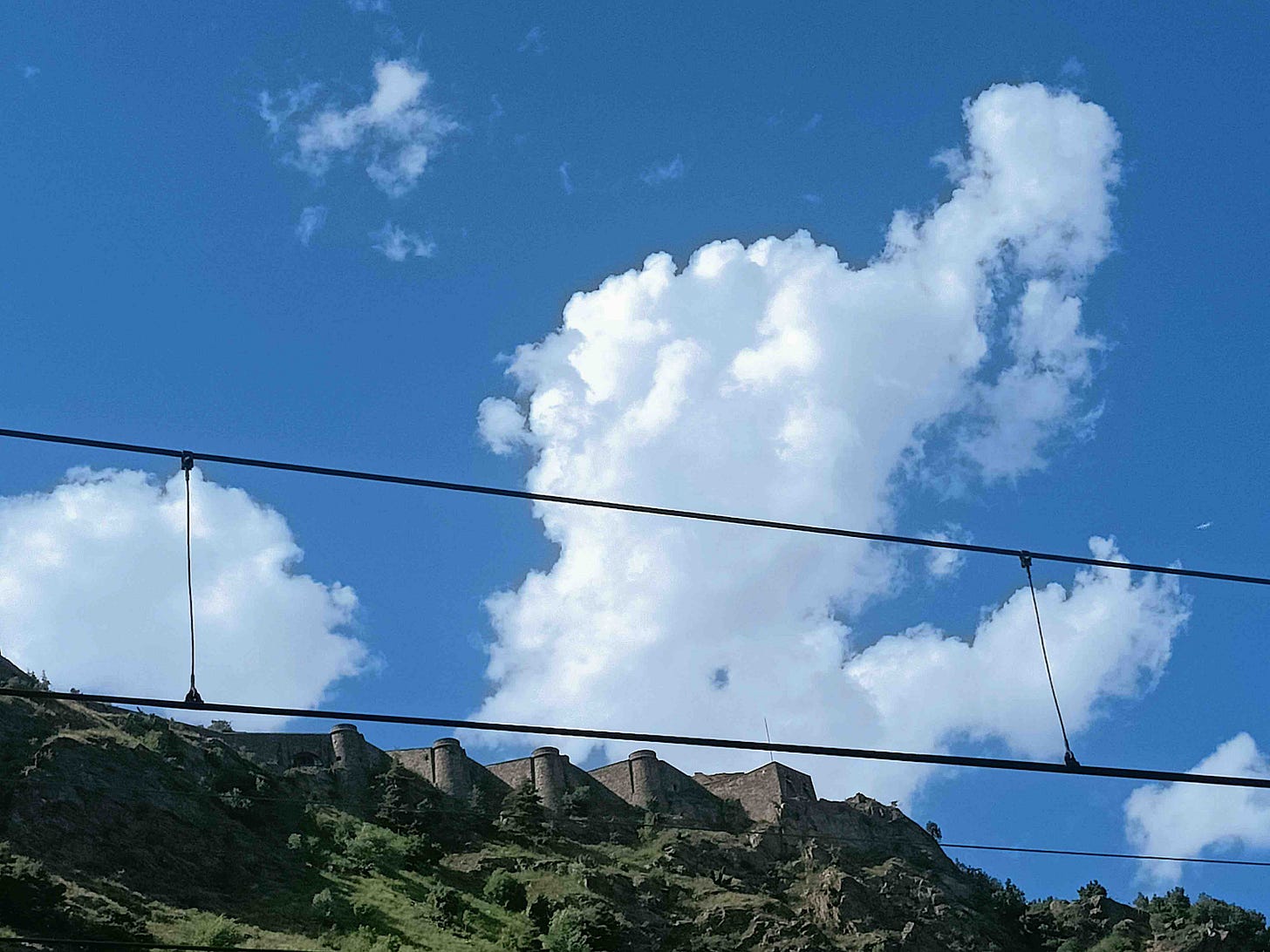Immigration And Intimacy
Excerpt from Italian Travels
The Cloud Caravan a few posts back enjoyed a moment or two of buzz. I went looking while I was in Italy. Here’s a cloud in the Alpes drifting past an old fortress, a boxer cloud with a bellybutton.
You want to know where.
*
If there is one story, there are at least two ways to tell it even if there is one sky for all of us. True ?
If there is one story, there are an infinite number of perspectives, until the artist steps in and says, this is where we’re going.
A train platform where lives intersect, some randomly, some not, is a good place to begin. Randomness may possess aesthetic frisson, the shock delivered by the unaccountable. Intimacy is preferable; we learn more in depth.
Our age prefers the photographic reproduction. We are relieved of knowing anything about anyone. We enjoy the surface and move on, our fragmented attention quickly searching other live bodies.
Il Gattopardo, Tomasi di Lampedusa
Rereading Lampedusa’s Leopard on a short trip south, I realize the novel turns upon a single act of refusal, whose full force is only felt some forty years later.
The year is 1860. In fine-grained, Stendhalian prose, Lampedusa describes the tradition by which the Prince of Salina enters the convent in rural Donnafugata to pray “at the Tomb of the Blessed Corbèra, forebear of the Prince and foundress of the convent, who had endowed it, there lived a holy life and there died a holy death.” Donnafugata is the family’s summer estate, arrived at by arduous journey in coaches over rutted Sicilian roads, temperatures of 110° and more. Whether the party is exhausted the day after or not, the tradition remains: one visits the convent. The Prince leads a party of his daughters to the entrance, with one extra tagging along: Tancredi, his impoverished nephew, whom he loves deeply and supports.
The night before was the ‘welcome home’ dinner, to which town notables were invited, including Tancredi. Concetta, who believes Tancredi is about to propose, sits by his side. He is indeed about to. But once the Salina’s neighbor, no longer an awkward girl of uncertain class but a beauty back from finishing school in Florence, arrives, Tancredi is distracted. He remains faithful to Concetta but can’t help noticing. This is the meeting of two strangers.
Only two men may enter the convent: the Prince of Salina and the King of Naples. The party takes in the convent where they visit the garden, where the Mother Abbess shows them “the dank corner...where the saintly nun had suspended in air a huge stone which the devil, irritated by her austerity, had flung at her”; the two “famous and indecipherable letters framed on the wall of a cell, one to the Devil from the Blessed Corbèra, to convert him to virtue, and the other, the Devil’s reply.”
Tancredi wants to enter as well, he wants to see this holy place arm in arm with Concetta. Quick-witted, he knows the rules and cites them: the Prince of Salina may “enter together with two gentlemen of his suite if the Abbess so permits.” And yet it is Concetta who opposes his request. Her words are, “Let him be, father; he’s only joking; he’s been in one convent already, that ought to be enough for him; it’s not right for him to enter this one of ours.” The Prince does nothing, not wanting to get involved in a lovers’ spat. Tancredi departs red-faced and makes other plans. Garibaldi’s young bravo has been excluded from the world he wanted to enter.
Forty years later Concetta realizes the turn her life took when she made the choice between openness and refusal. Tancredi wanted to visit the convent and she denied him: against the rules. She could have taken Tancredi’s side; he wanted to come because she was there. If she had relented, the entire second half of the novel changes.
Just so our life is composed of an infinite series of moments when we choose between one thing and another, liberty and conformity, never realizing the import of our actions until later. No matter how slowly we go, no matter how thoughtfully, we go on nerve and character, making choices that turn us into prisoners of our will.


